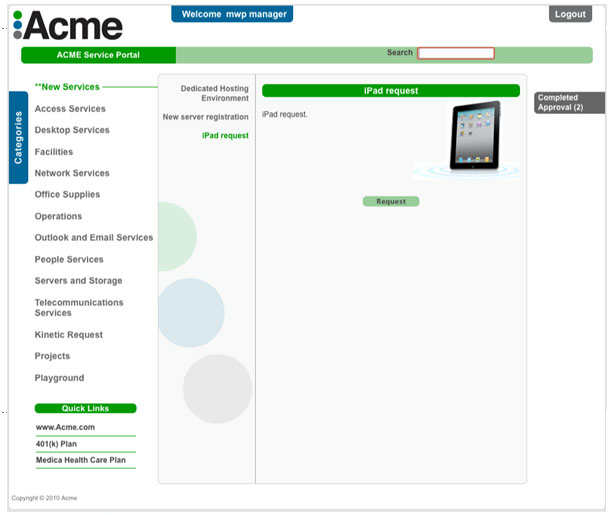What’s New at Kinetic: Building Smart in 2026
At Kinetic, we believe the future of Business Process Management isn’t bigger—it’s smarter.
Fueled by ITIL recommendations, innovative vendor offerings, and industry analyst endorsements, service catalogs have emerged over the past several years as the preferred method for presenting IT...

Fueled by ITIL recommendations, innovative vendor offerings, and industry analyst endorsements, service catalogs have emerged over the past several years as the preferred method for presenting IT services to users. Requesting “service items” like a new laptop, access to the corporate ERP system or printer maintenance is now commonly done through a service catalog application.
Some forward-thinking organizations have taken the service catalog concept beyond IT, extending it to include services from other groups like HR (vacation requests), finance (travel expense reimbursement) and facilities (a new office chair).
 But such extensions are often problematic and cumbersome, because service catalogs are often bolt-ons to core IT service management (ITSM) applications. Since these applications aren’t designed for general business use, it’s difficult for business function managers to define and tweak service item definitions and fulfillment processes without extensive (and expensive) IT assistance.
But such extensions are often problematic and cumbersome, because service catalogs are often bolt-ons to core IT service management (ITSM) applications. Since these applications aren’t designed for general business use, it’s difficult for business function managers to define and tweak service item definitions and fulfillment processes without extensive (and expensive) IT assistance.
As a result, non-IT services are often presented to users via different systems (or at least different user interfaces), forcing users to learn multiple request systems and to know which to use for specific types of service requests. But business users don’t care which department is delivering a given service, or even if multiple departments have to coordinate tasks for fulfillment (such as onboarding a new employee). They just want it done, and they want it to be simple.
Consequently, industry analysts today say that “service catalogs” (an IT term) need to evolve into “request management” (a business term) systems. ITSM applications may still serve essential functions within the fulfillment process (along with HR, finance, ERP and other applications) but need to be coupled with a single, unified, user-friendly, web-based and mobile-enabled front-end portal: one request interface to use, any time, any where, for any type of service request.
Analysts refer to these as Systems of Engagement (the unified request management portal) for Systems of Record (the back-end ITSM, ERP, HR, finance and other apps). In other words, using a flexible, intuitive user interface to leverage existing investments in the enterprise applications which do the heavy lifting of service delivery, while shielding business users from unnecessary complexity.
In an enterprise request management implementation, service requests can be entered through a user-friendly portal interface (or triggered by events in other systems), with all subsequent tasks—approvals, scheduling, delivery, feedback collection, costing, and reporting—managed by an automated task workflow engine capable of secure communication with and between enterprise applications and federated data sources.
Business managers can create, manage and modify their own tasks with minimal IT involvement. The end result? A great concept—IT service catalogs—can be practically extended into any function in the organization, without an expensive and disruptive “rip and replace” implementation or any unnecessary complexity for department managers or business users.
To learn more, check out these white papers:
Agility is the Key to Request Management Software
Using Service Catalogs to Run IT As a Business (Not Like a Business)

At Kinetic, we believe the future of Business Process Management isn’t bigger—it’s smarter.

IT support automation uses software workflows, rule engines, AI/ML, and integrations to automate...

Business process reimagined is the strategic renewal of how work gets done by combining modern digital...